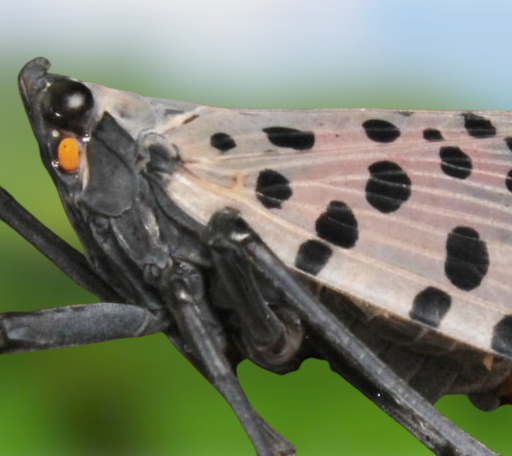Spotted lanternflies, or Lycorma delicatula, are originally from China but were discovered in Pennsylvania for the first time in September 2014. Spotted lanternflies eat a wide variety of trees, including fruit, ornamental, and woody ones. Tree-of-heaven is one of their favorite foods. The invasive spotted lanternfly can be transported over large areas by individuals transporting infested material or products containing egg masses. This pest poses a significant threat to the United States wine, orchard, and logging sectors if allowed to proliferate.
Egg masses, nymphs, and adults of the spotted lanternfly can hitchhike on trees, plants, bricks, stones, logs, building materials, patio furniture, automobiles, and equipment such as lawnmowers.
Adults and immatures get their nutrition by sucking the sap out of plant trunks, stems, and leaves. Nymphs spend most of their time crawling around on the ground. Honeydew is a sweet waste product that is produced by these creatures while they are eating. The honeydew attaches to the leaves and fruits, attracting additional pests and encouraging the development of sooty mold, which devalues and taints fruits, hinders photosynthesis, and lowers the general health of the plant.
Spotted Lanternfly Infestation
A planthopper known as the spotted lanternfly is found in New York City. Even though it makes trees sick, it is not thought to be a major threat to the forests in the city. Despite this, it poses a considerable risk to a wide variety of crops, including apples, walnuts, hops, blueberries, grapes, and stone fruits, among others. The Tree of Heaven is the ideal host tree for this species and is necessary for its offspring to develop.
The spotted lanternfly is responsible for significant harm to trees, vines, crops, and many other kinds of plants, including the exudation of sap, wilting, and curling of leaves, as well as dieback. The spotted lanternfly usually doesn’t kill trees; instead, it infests them. Despite its potential to reduce a tree’s resistance to disease and other pests, the spotted lanternfly is mostly a problem for crops.
Spotted Lanternfly Eggs
Planthoppers such as spotted lanternflies possess wings, however, they mainly jump or walk instead of flying long distances. The spotted lanternfly’s egg-laying season is in the fall, and the insects’ offspring appear in the spring. They often lay 30–50 eggs at a time on manmade or naturally hard objects like walls, trees, rocks, etc. During their development as nymphs, spotted lanternflies acquire wings and change color multiple times.
The eggs are roughly 1 inch in length and have a covering similar to mud that is grey. This covering tends to crack over time because it dries out. After some time, the shell peels away, revealing a clutch of 30–50 brown eggs that look like seeds and are arranged in 4–7 rows.
Spotted Lanternfly Origin
The invasive bug known as the spotted lanternfly (Lycorma delicatula), commonly known as SLF, is a planthopper, not a fly, which is why the name is deceptive. It initially showed up in Pennsylvania in September 2014, and since then it has expanded to at least half a dozen additional states. Because the spotted lanternfly can only fly for short distances and travels across big areas mostly by jumping or walking, human actions are primarily responsible for transferring it across huge areas.
Spotted Lanternfly Control
Spotted lanternflies cause a lot of damage to residential gardens. They are not harmful to humans or animals and do not cause damage to buildings by eating wood. They don’t destroy trees but they can put a lot of strain on them, so taking care of the plants with good watering, soil, and mulching methods is essential.
To manage these pests, the following actions should be taken:
Crush adults and nymphs with gloved hands, stamp on them with the foot or drown them in a vessel of water and soap or isopropyl alcohol to get rid of them.
To remove egg masses from plants and hard surfaces like patio furniture, decks, and concrete, use a plastic card or instrument like a putty knife to scrape the area clean.
Although spiders, praying mantises, predatory stink bugs, and assassin bugs, are capable of keeping existing spotted lanternfly populations in check, they are not yet present in sufficient numbers to do so with newly established ones. Despite this, incorporating a wide range of flowering plants and other sorts of plants into landscaping often assists in the maintenance of generalist natural enemies.
Use neem oil or insecticidal soap under the product’s labeling directions. Using them on the spotted lanternfly and the surfaces it feeds and walks on is an effective method of control. It is recommended d to reapply insecticidal soap or neem oil at the intervals specified on the label because of their brief residual activity.



